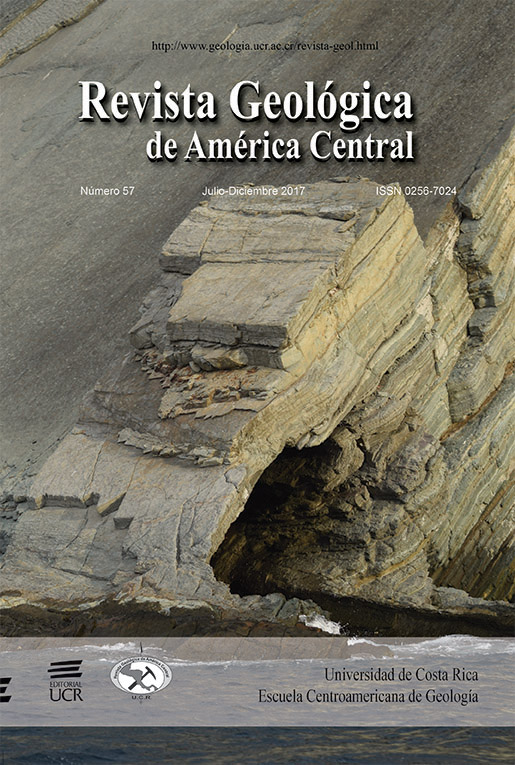Abstract
We document fossils of cichlid fishes from Costa Rica, the first fossil record of cichlids in Central America. These fossils are from shallow marine strata of Late Miocene age at the Proyecto Hidroeléctrico Reventazón and lake deposits of Middle Pleistocene age at San Miguel de Turrúcares. The occurrence of a Late Miocene cichlid in marine sediments in Costa Rica indicates a likely marine dispersal of cichlids from South America to Central America, and it also fits with the idea that cichlids crossed shallow marine waters to achieve their current distribution during the Miocene. The freshwater Middle Pleistocene cichlid fossils from San Miguel de Turrúcares indicate that, at least by the Middle Pleistocene, cichlids inhabited freshwater habitats in Costa Rica, as they now do across much of Central America.References
Alvarado, G. E. (1986). Hallazgos de megamamíferos fósiles en Costa Rica. Revista Geológica América Central, 4, 1-46.
Alvarado, G. (1989). Historia de la paleontología de los vertebrados en Costa Rica. In A. Ruiz and L. Camacho (eds.), Historia de la ciencia y la tecnología. El avance de una disciplina (pp. 273-289). Cartago: Editorial Tecnológica de Costa Rica.
Alvarado, G. E. (1994). Historia natural antigua: los intercambios biológicos interamericanos. San José: Editorial Tecnológica de Costa Rica.
Alvarado, G. E. and Gans, P. B. (2012). Síntesis geocronológica del magmatismo, metamorfismo y metalogenia de Costa Rica, América Central. Revista Geológica América Central, 46, 7-122.
Álvarez-del-Villar, J. (1978). Relación entre la geomorfología mesoamericana y la distribución actual de los peces. In I. Ferrusquía-Villafranca (ed.), Conexiones terrestres entre Norte y Sudamérica (Vol. 101, pp. 182-192): Universidad Nacional Autónoma de México, Boletín del Instituto Geológico.
Bardack, D. (1961). New Tertiary teleosts from Argentina. American Museum Novitates, 2041, 1-27.
Bowin, C. (1975). The geology of Hispaniola. In A. E. M. Nairim and F. G. Stehli (eds.), The ocean basins and margins (pp. 501-552). New York: Plenum.
Briggs, J. C. (1984). Freshwaters fishes and biogeography of Central America and the Antilles. Systematic Zoology Journal, 33, 428-435.
Carpenter, K. E. (2001). Suborder Laboroidei Cichlidae. In K. E. Carpenter and V. H. Niem (eds.), FAO species identification guide for fishery purposes the living marine resources of the western central pacific (pp. 3333-3336). Rome: FAO.
Casciotta, J. and Arratia, G. (1993). Tertiary cichlid fishes from Argentina and reassessment of phylogeny of New World cichlids. Kaupia, 2, 195-240.
Cassel, D. T. and Sen-Gupta, B. K. (1989a). Foraminiferal stratigraphy and paleoenvironments of Tertiary Uscari Formation, Limon Basin of Costa Rica. Journal of Foraminiferal Research, 19, 52-71.
Cassel, D. T. and Sen-Gupta, B. K. (1989b). Pliocene foraminifera and environments, Limon Basin of Costa Rica. Journal of Paleontology, 63(2), 146-157.
Chakrabarty, P. (2006a). Systematics and historical biogeography of Greater Antillean Cichlidae. Molecular Phylogenetics and Evolution, 39, 619-627.
Chakrabarty, P. (2006b). Taxonomic status of the Hispaniolan Cichlidae. Occasional Papers Museum of Zoology, University of Michigan, 737, 1-17.
Cockerell, T. D. A. (1923). A fossil cichlid fish from the Republic of Haiti. Proceedings of the United States National Museum, 63, 1-3.
Cooke, C. W., Garnder, J. and Woodring, W. P. (1943). Correlation of the Cenozoic formations of the Atlantic and Gulf coastal plain and the Caribbean region. Geological Society of American Bulletin, 54, 1713-1723.
Espinoza, G. J. (2012). Estudio de estanqueidad del embalse del Proyecto Hidroeléctrico Reventazón, Instituto Costarricense de Electricidad (Tesis de licenciatura inédita), Universidad de Costa Rica, San José.
Gómez, L. D. (n.d.). Cichlasoma turrucarensis, nov sp. from the Costa Rican Miocene. San José: Museo Nacional de Costa Rica. Unpublished manuscript.
Gómez, L. D. (1977). Bibliografía geológica y paleontológica de Centroamérica y el Caribe. San José: Museo Nacional de Costa Rica.
Graham, A. (1990). Late Tertiary microfossil flora from the Republic of Haiti. American Journal of Botany, 77, 911-926.
Hulsey, C. D., Keck, B. P. and Hollingsworth, P. R. Jr. (2011). Species tree estimation and the historical biogeography of heroine cichlids. Molecular Phylogenetics and Evolution, 58, 124-131.
Iturralde-Vinent, M. A. and Macphee, R. D. (1999). Paleogeography of the Caribbean region: Implications for Cenozoic biogeography. Bulletin of the American Museum of Natural History, 238, 1-95.
Kullander, S. O. (1986). Cichlid fishes of the Amazon River drainage of Peru. Stockholm: Swedish Museum of Natural History.
Lucas, S. G., Alvarado, G. E. and Vega, E. (1997). The Pleistocene mammals of Costa Rica. Journal of Vertebrate Paleontology, 17, 413-427.
Malabarba, M. C., Zuleta, O. and Del Papa, C. (2006). Proterocara argentina, a new fossil cichlid from the Lumbrera Formation, Eocene of Argentina. Journal of Vertebrate Paleontology, 26, 267-275.
Martin, A. P. and Bermingham, E. (1998). Systematics and evolution of lower Central American cichlids inferred from analysis of Cytochrome b gene sequences. Molecular Phylogenetics and Evolution, 9, 192-203.
Miller, R. R. (1966). Geographical distribution of Central American freshwater fishes. Copeia, 773-802.
Murray, A. M. (2001a). The oldest fossil cichlids (Teleostei: Perciformes): Indication of a 45 million-year-old species flock. Proceedings of the Royal Society of London, B 258, 679-684.
Murray, A. M. (2001b). The fossil record and biogeography of the Cichlidae (Actinopterygii: Labroidei). Biological Journal of the Linnean Society, 74, 517-532.
Myers, G. S. (1966). Derivation of the freshwater fish fauna of Central America. Copeia, 4, 766-773.
Pizarro, D. (1993). Los pozos profundos perforados en Costa Rica: aspectos litológicos y bioestratigráficos. Revista Geológica America Central, 15, 81-85.
Říčan, O., Piálek, L., Zardoya, R., Doadrio, I. and Zrzavý. (2013). Biogeography of the Mesoamerica Cichlidae (Teleostei: Heroini): Colonization through the Gaarlandia land bridge and early diversification. Journal of Biogeography, 40, 579-593.
Schaeffer, B. (1947). Cretaceous and Tertiary actinopterygian fishes from Brazil. Bulletin of the American Museum of Natural History, 89, 1-39.
Taylor, G. D. (1975). The Geology of the Limón area of Costa Rica part. 1-2. Bulletin of American Paleontology, 9(39), 179-460.
Woodward, A. S. (1898). Consideraçoes sobre alguns peixes Terciarios des schistos de Taubaté, Estado de São Paulo, Brasil. Revista do Museo Paulista, 3, 63-70.
Woodward, A. S. (1939). Tertiary fishes from Maranhao, Brazil. Annals and Magazine of Natural History, 11(3), 450-453.






